 |
Howard County--1875 |
This is a NEGenWeb Project web page
and is presented as part of the
MARDOS Memorial Library Collection.
Howard County--1875
|
Howard County was organized when a bill, authorizing same, was passed in our legislature March 28, 1871. The Czech colony in this county was established with the aid of the Slovania Colonization Club in Omaha, mention of which has been made in the introduction. In March, 1875, Vaclav L. Vodicka and Matej Nemec of Omaha and Vavrinec Dobes of New Prague, Minn., as committee were sent out to investigate suitable lands for a colony. They recommended Howard County, especially that part lying between the Loup rivers and west of St. Paul, near the former postoffice called Warsaw. 1875--The Following Came: Good homesteads were gone, so the settlers were obliged to buy farms. The first who came, in March, 1875, was Martin Vacek (born in Laziste 1827, died August 15, 1881, on board a ship, on his way to visit his native land) from New Prague, Minnesota. He bought a partly improved farm, n. w. quarter 30-14-10, with buildings, from John C. Burch, for $1,500.00. His five sons came with him, the oldest of whom, Peter, later bought n. e. quarter 30-15-10 and another son, Matej, n. e. quarter 19-14-10. Vavrinec Dobes, bought s. w. quarter 30-14-10; Jacob Kubes, Vacek's son-in-law, s. w. quarter 19-14-10. 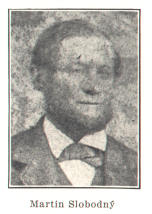
Martin Slobodny (born in Ponedraz) bought n. w. quarter 10-14-11, where later the Czech Catholic cemetery called Warsaw was established. John, Joseph, Vaclav and Anton Holecek, born in Vycapy near Caslav, came to Schuyler April 25th, 1875. John and Joseph bought the south half 30-15-11, Vaclav s. w. quarter 26-15-12 and Anton s. e. quarter 14-15-12. Matej Suchanek, born in Vylantice near Bystrice, bought n. e. quarter 30-15-11. John Svoboda came June 5th with his son, Charles V., both born in Jaromerice, Moravia. Chas. V., having received a good education in his native land, later became prominent here among his compatriots. He was the first Czech to hold political office, having been county clerk six years (three terms). In 1900 he was nominated for state secretary by the following parties: Populist, Democrat and Silver Republican. In 1928 he was nominated for state auditor on the Democratic ticket. He has been active in various farm organizations, as Farmers' Alliance, Farmers' Union and Farm Bureau, also a member of the State Constitutional Convention, 1919-1920, and legislature, 1923. Vaclav Toman, Prusice, County Cerny Kostelec, bought 28-16-11; His son Joseph Toman, same birthplace, 29-16-11; Anton Francl, Svihov, s. w. quarter 22-15-11; John Pokorny, Znojmo, Moravia, bought n. w. quarter 28-15-11, where later the Bohemian National cemetery was established; Matej Blaha, Znojmo, Moravia, south half 28-15-11; Anton Chalupsky, born in Tyn, bought 33 and 34-16-11. 1876--The Following Came: 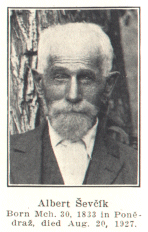
Vojtech Sevcik, born in Ponedraz near Lomnice. Came from Winona, Minnesota, and bought s. e. quarter 34-15-11, later five more quarters, and five of his six sons own and cultivate these farms creditably. Jacob Sevcik, Vojtech's brother, same birthplace, 9-14-11; Jacob Trubl, his brother-in-law, born Krtenov, s. w. quarter 35-15-11; Joseph Trubl, his brother, same birthplace, n. w. quarter 35-15-11; John Komzak, Komarov near Sobeslava, came with Sevcik from Minnesota, bought s. w. quarter 26-15-11; John Safarik, Zensice near Caslav, n. e. quarter 34-15-12; Vaclav Horky, Caslav, s. e. quarter 6-14-11; Joseph Pavlik, Vycapy, n. w. quarter 24-15-12; John Svoboda, Koukalka, Caslav, n. e. quarter 14-15-12; John Manasek, Koukalka, Caslav, s. e. quarter 18-15-11; Vaclav Fiser, Brambory, n. e. quarter 22-15-11. 1877--The Following Came: Bartolomej Bartizal, Caslav, s. e. quarter 8-14-10; Frant. Cilek, Sobeslav, Tabor, 12-14-11; Martin Cilek, same birthplace, 11-14-11; Martin Papousek, Volesna, Trebon, came from Winona County, Minnesota, bought south half 31-15-10. 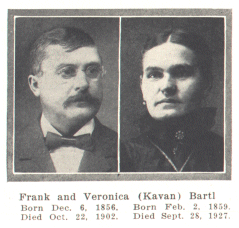
Frank Barta (Bartl), Krtenov, Vltavotyn. For many years conducted a business in St. Paul. After his death, his widow (born Veronica Kavan) managed it until her death in 1927. Frank Manasil, born in Moravia, came from Winona County, Minnesota, with the preceding. Bought east half of s. w. quarter 3-15-11, where for many years he did blacksmithing, at the same time being sexton of the church. John Hurt, Oujezdec, Caslav, s. w. quarter 2-14-12; Anton Hurt, Dubina, s. e. quarter 4-14-12; Frank Suntych, Dubina, n. e. quarter 10-14-12; Frank Bures, Lestina, s. e. quarter 3-14-12; Frank Nesyba, Slavikovice, Jemnice, Moravia, s. w. quarter 34-15-12; Joseph Jerabek, Hrabesin, Kutna Hora, s, w. quarter 33-15-12; Vaclav Novak, Bucice, Caslav, n. w. quarter 33-15-12; Joseph Bartunek, Oujezdec, west half of s. e. quarter 33-15-12; Matej Mrkvicka, s. w. quarter 3-14-12; Vaclav Hurt, n. e. quarter 9-14-12; John Kopta, Horka, Caslav, n. w. quarter 29-15-11; Jos. Ambroz, Becice Hluboka, n. w. quarter 18-15-11; Vojtech Ambroz, same birthplace, east half of s. e. quarter 22-15-11; Frank Ambroz, same birthplace, n. e. quarter 26-15-11; John Pazdera, Tupes, Prelouc, n. e. quarter 29-15-10; Anton Spilinek, Skuhrov, Habry, n. w. quarter 26-16-12; John Tuma, Janov, Selcany, n. w. quarter 22-16-12; Jos. F. Tuma, Lhota, Selcany, n. w. quarter 26-16-12; Joseph Tuma, Lhota, Selcany, n. e. quarter 26-16-12; Vaclav Krepela, Elstyn, Hor. Tyn, n. e. quarter 27-16-12; Linhart Vlach, Radoves, Domazlice, west half 14-16-12; John Moravec, Damirov, s. w. quarter 22-16-12; Frank Moravec, Opatovice, n. w. quarter 27-16-12; J. Coufal, Opatovice, Caslav, n. w. quarter 5-16-12; Vaclav Ingerle, Dunajovice, Moravia, west half s. w. quarter 34-16-11; M. Kment, 320 acres in 10-16-12; L. Ondrak, s. w. quarter n. w. quarter 10-16-12; Leopold Rubes, 240 acres in 10-16-12; Vaclav Klanecky, Dolni Krupa, Nem. Brod, n. w. quarter 14-15-12; Joseph Klanecky, same birthplace, s. w. quarter 11-15-12; John Dvorak, s. e. quarter 10-15-12; Frank Klepetko, s. e. quarter 15-15-12; Anna Horalek, Rohozec, Caslav, n. e. quarter 4-15-11; M. Jelinek, Jilovice, Vltavotyn, s. w. quarter 22-15-11; Jacob Novotny, Petrinov, Trhove Sviny, n. e. quarter 28-15-12; Jacob Jon, Sedlovice, Netolice, n. e. quarter 18-14-10. The Following were Early Pioneers: 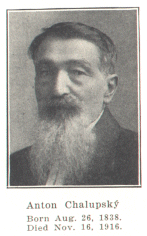
Joseph Novotny, Tabor (came 1878) bought n. e. quarter 31-15-10; John Kafka. Habry, Caslav; Charles Tenopir, tailor; Joseph Jares, Horusice; Joseph Puncochar, Vodnany; Frank Klanecky, Dolni Krupa, Nem. Brod; John and Jacob Vincik; John Vasa, Brambory, Caslav; John and Anton Lank. John and Frank Lhotka, bought west half s. w. quarter 6-14-12. Frank Lhotka lost his reason. He was placed in the Hastings asylum for treatment, escaped and was never found. The center of the colony for a long time was located in the vicinity of the Czech Catholic church of St. Wenceslaus in Warsaw, Warsaw Precinct. Those who came later were obliged to buy land more distantly located, for prices were rising. One group settled on Turkey Creek, southwest of Farwell (Posen). Some bought in the valley of North Loup River, in the neighborhood of Anton Chalupsky, north of Elba. And still others on the high tableland between Munson Creek and North Loup river, south of Cotesfield, while others settled southeast of St. Paul, in a rather sandy bottom, in the valley of the Middle Loup River, between that and the Sand Hills. Several young men obtained employment in the town of St. Paul and later established business there. Among these were: Frank Polansky, druggist, born in Kladno; Joseph Vavra, general merchandise, Driten near Budejovice; Frank Vavra, wheelwright and farm implements; Anton Gruber, Kutna Hora, brickyard; Vaclav (James) Shalda, Jehnedi near Litomysl, harness maker; Frank Barta (Bartl), Krtenov, Vltavotyn, general merchandise, came from Winona, Minnesota; J. J. Sazama, Radonice near Domazlice, general merchandise; Joseph Kotik, Manitowoc, Wisconsin, general merchandise. These settled in Elba: Joseph Zavitka, meat market; Alois Moravec, Leskovice, Habry, blacksmith; Matej Naprstek, Cerveny Ujezd, Unhost, harness maker. 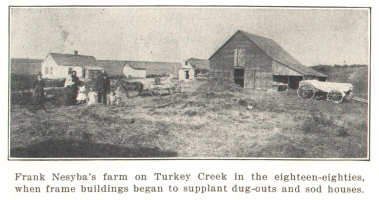 The Czech pioneers here had their share of trouble, as could not be otherwise. They found themselves on a bare prairie, without fuel or water. The few dollars that each brought were spent for a yoke of oxen, wagon, plow and payment on the land. There was no way of earning money, no one had money to hire help. Consequently the new settlers found it almost impossible to get credit. In the spring of 1876 Matej Suchanek and Joseph Pavlik each bought a sack of flour from Christ. Crowe, who had a water mill on Oak Creek, for the price of $5.00 per sack, and each gave him a mortgage on his pair of oxen and wagon--being all the personal property each had. With the exception of a few, all had been farmers, some in their native land, others in this country, and they went to work in earnest. It is difficult to imagine the sensations of these pioneers, their anxieties and hopes, when they turned the first furrow. Surely they deserve admiration for their persistence and patience while battling for an existence. During the first three years swarms of grasshoppers destroyed the result of their labor, so that many of the settlers were plunged into a desperate situation. When the pests ceased their depredations and our people were able to raise crops, despite low prices they paid their debts (that being a Czech trait), got credit and began to prosper. This endurance, industry and thrift which they practiced enabled them to lay the foundation for a comfortable living and the younger generation is reaping the benefit of it. This colony might have grown to larger proportions, as those in other parts of the states have, had it had proper guidance. But the Omaha organization paid no attention to it and no system was used in settling newcomers. The result was that they settled in a scattered fashion and thereby co-operation, so needed in those days, was impossible. Alas, but few of the early settlers looked far enough ahead to insure more land in time (as did Vojtech (Albert) Sevcik), so that when their children were grown and lands were more expensive, the majority had to go elsewhere. That is why the colony today numbers only about 270 families, but little more than in the beginning. 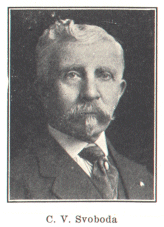
The following sketch, written by Charles Vincent Svoboda of St. Paul, who has supplied the information about Howard County for this history, is an example of what the first Czech settlers in this county experienced: "We came to Schuyler August 22, 1874. My father, heeding the advice of several of his compatriots, built a home and store building, where he established a meat market. Having difficulty in doing business without the knowledge of English, he became a member of the Bohemian Colonization Club Slovania and in March 1875 moved to Howard County, where he bought land three miles northwest of where the town of Farwell now stands. About June first we set out from Schuyler in a wagon drawn by a yoke of partly broken oxen, a spring wagon drawn by a span of ponies, and one cow, arriving at Martin Vacek's place on June 5th. The following day father hired a man to get a load of lumber from Grand Island, twenty-four miles away. When it was brought, we moved on our land in Sec. 24, T. 15, R 12, and began to construct a house 14x18. I was sixteen, the youngest of the family and the only boy I had never done any manual labor before, having spent all my time in schools in Bohemia. However, I had watched carpenters at work in Schuyler and felt confident I could build a house. My father helped me, but it took us several months to finish it. In the meantime we had nothing but the covered wagon for shelter against rain, wind and scorching sun. After completing the framework, we made several thousand dry brick, with which father bricked the spaces between the studding and finished by plastering the walls. While there was not much style or architecture to it, the house proved warm and comfortable the following winter and I surely thought more of it than of any I have had since. Most of the other settlers had sod houses or dugouts, that is, an abode partly dug out in a bank and finished with sod. Those who were able to make roofs of boards succeeded in having a practically waterproof covering, but some used only willow brush, grass or yellow clay, and in rainy weather the water trickled down, necessitating the use of an umbrella and other protection. After erecting some kind of a dwelling, the next problem for the settlers to solve was that of getting water. There is plenty of good water in Howard County at a uniform depth, but in some localities getting it was not an easy task. Practically all of the first wells were dug by hand, varying in depth from 30 feet on creek or river bottoms to 250 feet on the north tableland. I dug four such wells myself, at various times and places on the farm. John Pokorny and Jacob Blaha bought a well auger and drilled many deep wells, taking pay in anything of value, in trade, especially sorghum syrup. Many farmers planted sorghum, which did well in the newly-broken ground, and they had it made into syrup at the Warsaw postoffice, where a mill was operated. 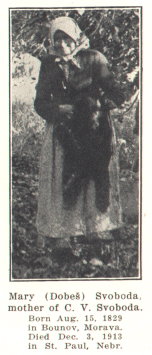
The next important problem was fuel. Sunflowers growing in the ravines, dry buffalo chips and dry grass were used, which later led to the introduction of hay stoves. Timber grew along the Loup rivers and some of the creeks, but the majority of such lands were already taken. We had to go eighteen miles to Davis Creek, or twenty-four miles to Rock Creek, for wood. That meant a drive of forty-eight miles, beside cutting and loading the wood, all during a short winter day. Deer were scarce, but there was plenty of white-tail jackrabbits, prairie chicken, quail and thousands of wild geese and ducks in the fall and spring. A peculiar feature of the country were the prairie-dog towns. These animals, the largest of the gopher family, live in deep burrows in the ground, eight to twelve in one family, in compact colonies, covering thousands of acres in some localities. The largest dogtown in Howard County used to be above Elba, in the North Loup valley, extending nearly four miles up the river. Others were on Turkey Creek, Oak Creek and Middle Loup bottoms. Their cheery "yip-yip-yip" used to greet the passer-by as, sitting on the mounds in family groups around the entrance to their abode, they would flip, flip, flip their little tails and disappear when anyone approached. Here and there an owl or a rattlesnake would follow, sometimes into the same hole. Rattlesnakes used to be quite numerous in these dog-towns and were a menace to early settlers. Horses, dogs and people were bitten by them. Frank Nesyba's wife, on Turkey Creek, was one of their victims, but fortunately was saved by the use of whiskey, the only remedy known. John Safarik's little boy did not escape as easily and died from the bite of a snake. During the first summer I killed a dozen of them, of various sizes. In August of that year (1875) I went with Mat. Suchanek on a hunting and reconnoitering expedition to the North Loup river. We walked along the old military trail on John M. Parker's farm, near the present Cotesfield townsite, each carrying an old-country muzzle loader, ready to shoot. Suchanek followed the left trail and I the right. Suddenly a rattling sound drew our attention to a big snake coiled near the road, about three feet from Suchanek's knee. He was right in the act of coiling backward and ready to strike. Suchanek, scared stiff, stood like a "pillar of salt," unable to move. I stepped back, dropped the gun and shot the snake just in time to prevent his deadly stroke. Upon examination we found that my shot had cut off the head and what looked like half the rattles, still leaving twenty-nine of them. Upon measuring the reptile, we found he was seven feet and two inches long, the biggest rattler I ever saw. Gradually they were exterminated. When the land became more valuable, efforts were made to kill off the prairie dogs, with only partial success, until a few years ago, when the Department of Agriculture found an effective method after a series of experiments. There are still a few prairie dogs in places, but their towns are a thing of the past in Howard County. I saw plenty prairie fires and fought a great many, but must say that most of the stories we read about them are exaggerated. At times they caused considerable damage, but no one needed to fear loss of life if common sense was used. As to blizzards and snow storms, I was in all the snow storms and in many of the old-fashioned Nebraska blizzards since 1875 without getting even a chilblain. Most of the suffering caused by such storms in the early years was because of lack of experience, judgment and fore-thought. The biggest snowfall occurred in the winter of 1880-1881, accompanied by a severe cold. A Czech pioneer named Novotny froze to death that winter, while walking from St. Paul to his farm, three miles away. I was starting for home at dusk, a distance of fourteen miles, with a load, and saw him walking with some groceries. It was snowing and apparently he took a short cut across a field after he got out of town. He lost his way and walked in a circle around a strawstack and was found dead the next morning. The snowdrifts were so high that his funeral had to be postponed for several weeks, the roads being impassable. That winter many farmers, not being able to get flour after their supplies gave out, ground wheat in coffee-mills. The worst affliction were the migrating locusts, usually called grasshoppers. In 1875 they damaged the crops, but we had a little wheat left for the few chickens, for the manufacture of cereal coffee (an invention of pioneer women, the Postum of the present time) and for some flour to be ground in the Dannebrog and Oak Creek grist mills. In 1876 we broke about thirty acres of prairie. Mother and I planted all of it with corn. There was plenty of rain and the corn grew rapidly, reaching a height of 6-7 feet by the latter part of July. It tasselled out and began forming large ears, when one hot, sunny day the wind suddenly changed and myriads of grasshoppers began to come down. They stayed a few days, waiting for a favorable wind to help them resume their journey, and of course in the meantime eating everything in sight. Our field of big corn was reduced to stubs of stalks about a foot high. Vegetation of any kind disappeared and consequently absolutely nothing was raised that year. People actually suffered. Some aid was brought from the east, but the Czech settlers never got any of it. The following year a very good crop of wheat was raised, but much of it was lost on account of a dearth of harvesting machinery. 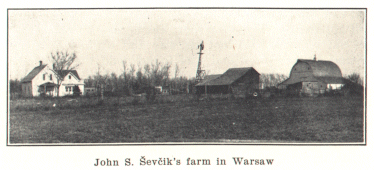 Frank Kelly bought a new header and undertook to harvest about 400 acres for a number of farmers. He agreed to cut mine and I was to work with the header. We labored night and day for over two weeks, cutting a good share of the wheat after it was half shattered. It was heavy and the work was hard. Nobody had sufficient experience in handling headed grain. Stacks were not built right and got wet. After the wheat was threshed, we had to spread it on the ground to dry. When we had a load dried, I made my first trip to market, a trip I shall never forget. I loaded fifteen sacks of wheat on my spring wagon and set out for our nearest grain market, Grand Island, thirty-two miles away. I took some food along, stopped a while at noon to eat and feed the horses. While I lay under the wagon and napped, the horses ate the rest of my lunch. The roads through the sandhills were bad and I arrived in Grand Island after four o'clock. Charles Wasmer, one of the two grain buyers, looked at my wheat and offered me forty cents per bushel, saying it was not dry enough. The other grain buyer would not even look at it. I drove to Jake Sasse's livery barn, put the team in, fed the horses some of the wheat and crept up in the hay-loft, where a number of farmers were lodging for the night. In the morning I paid twenty-five cents for the team, all the money I had and, hungry, started for home with my wheat. I arrived in the evening and never shall forget the expression on my mother's face, when she realized that I had brought home neither money nor the provisions, so badly needed. Other settlers made the same trips with their ox-teams. They generally left home in the evening, travelled all night, and reached Grand Island the next day in time to sell their grain before evening. The trip home required the following day and night. Some raised a few hogs. Having no other market, they butchered them and took them to Grand Island, where they were offered one and a half cents per pound. I sold eggs at 5 cents per dozen and good butter at 5 cents per pound. Our county and the farmers therein were obliged to endure another crisis in later years, that of drouth. The year 1893 was quite dry, crops were light, but the year following was memorable. There was not enough moisture even in the spring and no crops at all were raised. The farmers had to sell stock, for they had nothing to feed it, and many became impoverished. This drouth affected the whole state. Contributions were gathered in other states and a quantity of provisions and clothing sent and distributed. I was county clerk at the time and most of these supplies were sent to me and upon my responsibility. It was very difficult to distribute supplies among the right people. I never knew, until then, how low some people can sink, just to get something of which they were not nearly as needy as others. I spent many a sleepless night and got a great many more gray hairs while engaged in that office, from which I would have liked to have resigned, had it not appeared like cowardice. The only alleviating feature for me was the fact that Czechs behaved honorably in that trying time. Everyone who in any way participated in the distribution was subjected to suspicion, gossip and enmity and so I was very much surprised when the following campaign (my third candidacy for county clerk, when I was the only candidate on my ticket), resulted in my election by a nice majority. Conditions have changed greatly. Groves were planted by the farmers and good buildings erected. Howard County looks much different today. However, these improvements represent but a small fraction of the wealth dug out of the soil by the diligent hand of the pioneer and the largest portion of it has been sent across the Missouri River for the enrichment of the industrial east. My father used to entertain very optimistic ideas about the United States. That and his desire to escape the oppressive Austrian rule and its militarism prompted him to emigrate. But the hardships of pioneer life, to which he brought us from a comparatively comfortable home, broke his heart and he took no interest in anything after the first two years. There are less than half a dozen of the old Czech pioneers left in Howard County. I was the youngest of the first settlers and am a sort of connecting link between them and the younger generation. Some left Howard County, but much the larger number have found rest there, that rest of which they had so little during their lifetime. They sleep in the several cemeteries, whose somewhat neglected appearance makes one wonder whether those of the younger generation realize or appreciate the work of the pioneer men and women, whose suffering and sacrifices made possible the advantages and comforts their descendants enjoy today.'' Czechs in Howard County live in and about St. Paul, Elba, Cotesfield and Farwell. |
| Back | Table of Contents | Next |